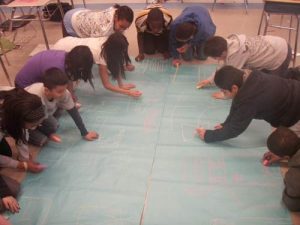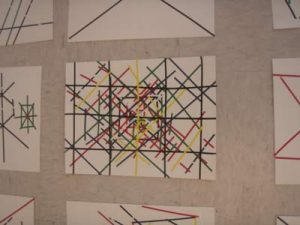By Leslie Ann Blake
UNC staff writer
The Durham VOICE
thedurhamvoice@gmail.com
A new center is in the works that will be built by the people, but more importantly, for the people.
The proposed Durham Urban Design Center’s main function will be to improve the community in ways the residents see fit, said Wanona Satcher, a consultant for Neighborhood Improvement Services.
“The citizens are telling us what to build,” Satcher said.

Children from Lowe’s Grove Elementary School draw their ideal neighborhood during a city planning lesson by Wanona Satcher. Satcher said input from residents will be vital as the Urban Design Center is created (Photo courtesy of Wanona Satcher).
NIS recently received a grant for $40,000 from the North Carolina Sustainable Communities Task Force. Satcher said a quarter of this money has been designated for the proposed center.
Though the center will serve all of Durham, it will be located in Northeast Central Durham. It will likely include meeting rooms, office space and classrooms, Satcher said. She expressed hope for an interactive library with architecture, photography and design books that residents can use to create models of their ideal neighborhood.
Satcher said that the director of NIS, Constance Stancil, best summarized the vision of the center’s purpose.
“The Durham Urban Design Center is whatever it needs to be,” Stancil said.
At its core, Satcher stressed, this center will be the physical base for NIS’s Livability Initiative. This program was started in 2010 as a response to a need for a citizen-based community improvement program.
“The Livability Initiative is about community engagement,” Satcher said.
The initiative’s programs include the Eastway Elementary Edible Garden, the Bull City Urban Market and the Bull City Safe Streets Program, according to its website. The initiative’s four areas, or “schemes,” are: Workforce and Economic Development, Safe and Healthy Living Environment, Multi-Functional Open Spaces and Coordinated Public Transportation.
Even though no location has yet been chosen for the center, Satcher said, vacant houses and old community centers are being considered as places to be renovated. Though there is no definite timeline, she said important steps are being taken to get the project underway.
“We are in full force now,” she said. “We’re ready to rock ’n roll.”
She said one of these steps is to start releasing briefs—which will be available on NIS’s website—informing residents about the center.
A step that is well underway is establishing partnerships with community, government and academic organizations, Satcher said. She hopes to involve students as interns from North Carolina Central University, Duke University, UNC-Chapel Hill, and North Carolina State University.
Another partner that Satcher believes will be essential in the creation of the center is Bull City Forward, a nonprofit that works to bring social innovation and entrepreneurship to Durham.
“Wanona has a good sensitivity to how a community can be brought together,” said Christopher Gergen, co-founder and executive director of Bull City Forward.
Gergen agreed with Satcher that community input is vital.

Artwork is displayed from Satcher’s city planning lesson at Lowe’s Grove Elementary School. Satcher said teaching children sustainability will be incorporated into the proposed Urban Design Center (Photo courtesy of Wanona Satcher).
“It’s about pushing citizens to think in innovative ways about what the community’s future should look like,” he said. “All of a sudden, your neighborhoods, your sidewalks look different, and you know you played a part. It’s an empowering experience.”
Gergen said he believes the center will become a hub of community resources in much the same way that Bull City Forward has. He said that a building like this should be a highly visible place where residents can just walk in.
“The more able we are to get different perspectives, especially from young people, the better,” he said.
It is important to teach young people sustainability to help them give an informed perspective, Satcher said. She recently visited Lowe’s Grove Elementary School to teach city planning. She had the students draw their ideal city.
“They were going to town, drawing basketball courts and sidewalks,” Satcher said. “Kids are pretty sustainable.”
Satcher said one student was extremely upset when Satcher drew a Walmart store over the children’s “neighborhood,” saying it was ruined.
“I had to remind her it’s a just a class,” she said.
Though the Urban Design Center will give the Livability Initiative a more tangible home, Satcher said it’s the intangible things, like the residents’ pride in and ownership of the community, that really matter.
“It’s not just about the buildings,” she said. “It’s about the lifestyle around it.”
Satcher, who has directed the Walltown Children’s Theatre’s modern production of the Nutcracker, said she would personally love to see a stage for performances inside the center.
“People love art, culture and entertainment,” she said, “no matter who you are.”
Satcher stressed her belief that improvements to Northeast Central Durham like the Urban Design Center will affect Durham as a whole.
“A downtown is only as good as the communities around it,” she said.
For a printer-friendly version of this post, click here.